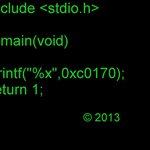mbed library sources
Dependents: Encrypted my_mbed lklk CyaSSL_DTLS_Cellular ... more
Superseded
This library was superseded by mbed-dev - https://os.mbed.com/users/mbed_official/code/mbed-dev/.
Development branch of the mbed library sources. This library is kept in synch with the latest changes from the mbed SDK and it is not guaranteed to work.
If you are looking for a stable and tested release, please import one of the official mbed library releases:
Import librarymbed
The official Mbed 2 C/C++ SDK provides the software platform and libraries to build your applications.
targets/cmsis/TARGET_STM/TARGET_STM32L4/stm32l4xx_hal_pwr_ex.c
- Committer:
- mbed_official
- Date:
- 2015-08-14
- Revision:
- 610:813dcc80987e
File content as of revision 610:813dcc80987e:
/**
******************************************************************************
* @file stm32l4xx_hal_pwr_ex.c
* @author MCD Application Team
* @version V1.0.0
* @date 26-June-2015
* @brief Extended PWR HAL module driver.
* This file provides firmware functions to manage the following
* functionalities of the Power Controller (PWR) peripheral:
* + Extended Initialization and de-initialization functions
* + Extended Peripheral Control functions
*
******************************************************************************
* @attention
*
* <h2><center>© COPYRIGHT(c) 2015 STMicroelectronics</center></h2>
*
* Redistribution and use in source and binary forms, with or without modification,
* are permitted provided that the following conditions are met:
* 1. Redistributions of source code must retain the above copyright notice,
* this list of conditions and the following disclaimer.
* 2. Redistributions in binary form must reproduce the above copyright notice,
* this list of conditions and the following disclaimer in the documentation
* and/or other materials provided with the distribution.
* 3. Neither the name of STMicroelectronics nor the names of its contributors
* may be used to endorse or promote products derived from this software
* without specific prior written permission.
*
* THIS SOFTWARE IS PROVIDED BY THE COPYRIGHT HOLDERS AND CONTRIBUTORS "AS IS"
* AND ANY EXPRESS OR IMPLIED WARRANTIES, INCLUDING, BUT NOT LIMITED TO, THE
* IMPLIED WARRANTIES OF MERCHANTABILITY AND FITNESS FOR A PARTICULAR PURPOSE ARE
* DISCLAIMED. IN NO EVENT SHALL THE COPYRIGHT HOLDER OR CONTRIBUTORS BE LIABLE
* FOR ANY DIRECT, INDIRECT, INCIDENTAL, SPECIAL, EXEMPLARY, OR CONSEQUENTIAL
* DAMAGES (INCLUDING, BUT NOT LIMITED TO, PROCUREMENT OF SUBSTITUTE GOODS OR
* SERVICES; LOSS OF USE, DATA, OR PROFITS; OR BUSINESS INTERRUPTION) HOWEVER
* CAUSED AND ON ANY THEORY OF LIABILITY, WHETHER IN CONTRACT, STRICT LIABILITY,
* OR TORT (INCLUDING NEGLIGENCE OR OTHERWISE) ARISING IN ANY WAY OUT OF THE USE
* OF THIS SOFTWARE, EVEN IF ADVISED OF THE POSSIBILITY OF SUCH DAMAGE.
*
******************************************************************************
*/
/* Includes ------------------------------------------------------------------*/
#include "stm32l4xx_hal.h"
/** @addtogroup STM32L4xx_HAL_Driver
* @{
*/
/** @defgroup PWREx PWREx
* @brief PWR Extended HAL module driver
* @{
*/
#ifdef HAL_PWR_MODULE_ENABLED
/* Private typedef -----------------------------------------------------------*/
/* Private define ------------------------------------------------------------*/
/** @defgroup PWR_Extended_Private_Defines PWR Extended Private Defines
* @{
*/
/** @defgroup PWREx_PVM_Mode_Mask PWR PVM Mode Mask
* @{
*/
#define PVM_MODE_IT ((uint32_t)0x00010000) /*!< Mask for interruption yielded by PVM threshold crossing */
#define PVM_MODE_EVT ((uint32_t)0x00020000) /*!< Mask for event yielded by PVM threshold crossing */
#define PVM_RISING_EDGE ((uint32_t)0x00000001) /*!< Mask for rising edge set as PVM trigger */
#define PVM_FALLING_EDGE ((uint32_t)0x00000002) /*!< Mask for falling edge set as PVM trigger */
/**
* @}
*/
/** @defgroup PWREx_TimeOut_Value PWR Extended Flag Setting Time Out Value
* @{
*/
#define PWR_FLAG_SETTING_DELAY_US 50 /*!< Time out value for REGLPF and VOSF flags setting */
/**
* @}
*/
/**
* @}
*/
/* Private macro -------------------------------------------------------------*/
/* Private variables ---------------------------------------------------------*/
/* Private function prototypes -----------------------------------------------*/
/* Exported functions --------------------------------------------------------*/
/** @defgroup PWREx_Exported_Functions PWR Extended Exported Functions
* @{
*/
/** @defgroup PWREx_Exported_Functions_Group1 Extended Peripheral Control functions
* @brief Extended Peripheral Control functions
*
@verbatim
===============================================================================
##### Extended Peripheral Initialization and de-initialization functions #####
===============================================================================
[..]
@endverbatim
* @{
*/
/**
* @brief Return Voltage Scaling Range.
* @retval VOS bit field (PWR_REGULATOR_VOLTAGE_RANGE1 or PWR_REGULATOR_VOLTAGE_RANGE2)
*/
uint32_t HAL_PWREx_GetVoltageRange(void)
{
return (PWR->CR1 & PWR_CR1_VOS);
}
/**
* @brief Configure the main internal regulator output voltage.
* @param VoltageScaling: specifies the regulator output voltage to achieve
* a tradeoff between performance and power consumption.
* This parameter can be one of the following values:
* @arg PWR_REGULATOR_VOLTAGE_SCALE1: Regulator voltage output range 1 mode,
* typical output voltage at 1.2 V,
* system frequency up to 80 MHz.
* @arg PWR_REGULATOR_VOLTAGE_SCALE2: Regulator voltage output range 2 mode,
* typical output voltage at 1.0 V,
* system frequency up to 26 MHz.
* @note When moving from Range 1 to Range 2, the system frequency must be decreased to
* a value below 26 MHz before calling HAL_PWREx_ControlVoltageScaling() API.
* When moving from Range 2 to Range 1, the system frequency can be increased to
* a value up to 80 MHz after calling HAL_PWREx_ControlVoltageScaling() API.
* @note When moving from Range 2 to Range 1, the API waits for VOSF flag to be
* cleared before returning the status. If the flag is not cleared within
* 50 microseconds, HAL_TIMEOUT status is reported.
* @retval HAL Status
*/
HAL_StatusTypeDef HAL_PWREx_ControlVoltageScaling(uint32_t VoltageScaling)
{
uint32_t wait_loop_index = 0;
assert_param(IS_PWR_VOLTAGE_SCALING_RANGE(VoltageScaling));
/* If Set Range 1 */
if (VoltageScaling == PWR_REGULATOR_VOLTAGE_SCALE1)
{
if (READ_BIT(PWR->CR1, PWR_CR1_VOS) != PWR_REGULATOR_VOLTAGE_SCALE1)
{
/* Set Range 1 */
MODIFY_REG(PWR->CR1, PWR_CR1_VOS, PWR_REGULATOR_VOLTAGE_SCALE1);
/* Wait until VOSF is cleared */
wait_loop_index = (PWR_FLAG_SETTING_DELAY_US * (SystemCoreClock / 1000000));
while ((wait_loop_index != 0) && (HAL_IS_BIT_SET(PWR->SR2, PWR_SR2_VOSF)))
{
wait_loop_index--;
}
if (HAL_IS_BIT_SET(PWR->SR2, PWR_SR2_VOSF))
{
return HAL_TIMEOUT;
}
}
}
else
{
if (READ_BIT(PWR->CR1, PWR_CR1_VOS) != PWR_REGULATOR_VOLTAGE_SCALE2)
{
/* Set Range 2 */
MODIFY_REG(PWR->CR1, PWR_CR1_VOS, PWR_REGULATOR_VOLTAGE_SCALE2);
/* No need to wait for VOSF to be cleared for this transition */
}
}
return HAL_OK;
}
/**
* @brief Enable battery charging.
* When VDD is present, charge the external battery on VBAT thru an internal resistor.
* @param ResistorSelection: specifies the resistor impedance.
* This parameter can be one of the following values:
* @arg PWR_BATTERY_CHARGING_RESISTOR_5: 5 kOhms resistor
* @arg PWR_BATTERY_CHARGING_RESISTOR_1_5: 1.5 kOhms resistor
* @retval None
*/
void HAL_PWREx_EnableBatteryCharging(uint32_t ResistorSelection)
{
assert_param(IS_PWR_BATTERY_RESISTOR_SELECT(ResistorSelection));
/* Specify resistor selection */
MODIFY_REG(PWR->CR4, PWR_CR4_VBRS, ResistorSelection);
/* Enable battery charging */
SET_BIT(PWR->CR4, PWR_CR4_VBE);
}
/**
* @brief Disable battery charging.
* @retval None
*/
void HAL_PWREx_DisableBatteryCharging(void)
{
CLEAR_BIT(PWR->CR4, PWR_CR4_VBE);
}
#if defined (STM32L475xx) || defined (STM32L476xx) || defined (STM32L485xx) || defined (STM32L486xx)
/**
* @brief Enable VDDUSB supply.
* @note Remove VDDUSB electrical and logical isolation, once VDDUSB supply is present.
* @retval None
*/
void HAL_PWREx_EnableVddUSB(void)
{
SET_BIT(PWR->CR2, PWR_CR2_USV);
}
/**
* @brief Disable VDDUSB supply.
* @retval None
*/
void HAL_PWREx_DisableVddUSB(void)
{
CLEAR_BIT(PWR->CR2, PWR_CR2_USV);
}
#endif /* defined (STM32L475xx) || defined (STM32L476xx) || defined (STM32L485xx) || defined (STM32L486xx) */
/**
* @brief Enable VDDIO2 supply.
* @note Remove VDDIO2 electrical and logical isolation, once VDDIO2 supply is present.
* @retval None
*/
void HAL_PWREx_EnableVddIO2(void)
{
SET_BIT(PWR->CR2, PWR_CR2_IOSV);
}
/**
* @brief Disable VDDIO2 supply.
* @retval None
*/
void HAL_PWREx_DisableVddIO2(void)
{
CLEAR_BIT(PWR->CR2, PWR_CR2_IOSV);
}
/**
* @brief Enable Internal Wake-up Line.
* @retval None
*/
void HAL_PWREx_EnableInternalWakeUpLine(void)
{
SET_BIT(PWR->CR3, PWR_CR3_EIWF);
}
/**
* @brief Disable Internal Wake-up Line.
* @retval None
*/
void HAL_PWREx_DisableInternalWakeUpLine(void)
{
CLEAR_BIT(PWR->CR3, PWR_CR3_EIWF);
}
/**
* @brief Enable GPIO pull-up state in Standby and Shutdown modes.
* @note Set the relevant PUy bit of PWR_PUCRx register to configure the I/O in
* pull-up state in Standby and Shutdown modes.
* @note This state is effective in Standby and Shutdown modes only if APC bit
* is set through HAL_PWREx_EnablePullUpPullDownConfig() API.
* @note The configuration is lost when exiting the Shutdown mode due to the
* power-on reset, maintained when exiting the Standby mode.
* @note To avoid any conflict at Standby and Shutdown modes exits, the corresponding
* PDy bit of PWR_PDCRx register is cleared unless it is reserved.
* @note The API returns HAL_ERROR when PUy bit is reserved.
* @param GPIO: Specify the IO port. This parameter can be PWR_GPIO_A, ..., PWR_GPIO_H
* to select the GPIO peripheral.
* @param GPIONumber: Specify the I/O pins numbers.
* This parameter can be one of the following values:
* PWR_GPIO_BIT_0, ..., PWR_GPIO_BIT_15 (except for PORTH where less
* I/O pins are available) or the logical OR of several of them to set
* several bits for a given port in a single API call.
* @retval HAL Status
*/
HAL_StatusTypeDef HAL_PWREx_EnableGPIOPullUp(uint32_t GPIO, uint32_t GPIONumber)
{
uint32_t position = 0x00;
uint32_t gpiocurrent = 0x00;
assert_param(IS_PWR_GPIO(GPIO));
assert_param(IS_PWR_GPIO_BIT_NUMBER(GPIONumber));
while ((GPIONumber >> position) != RESET)
{
/* Get current gpio position */
gpiocurrent = (GPIONumber) & (1U << position);
if (gpiocurrent)
{
switch (GPIO)
{
case PWR_GPIO_A:
if (gpiocurrent == PWR_GPIO_BIT_14)
{
return HAL_ERROR;
}
else
{
SET_BIT(PWR->PUCRA, gpiocurrent);
if ((gpiocurrent != PWR_GPIO_BIT_13) && (gpiocurrent != PWR_GPIO_BIT_14))
{
CLEAR_BIT(PWR->PDCRA, gpiocurrent);
}
}
break;
case PWR_GPIO_B:
SET_BIT(PWR->PUCRB, gpiocurrent);
if (gpiocurrent != PWR_GPIO_BIT_4)
{
CLEAR_BIT(PWR->PDCRB, gpiocurrent);
}
break;
case PWR_GPIO_C:
SET_BIT(PWR->PUCRC, gpiocurrent);
CLEAR_BIT(PWR->PDCRC, gpiocurrent);
break;
case PWR_GPIO_D:
SET_BIT(PWR->PUCRD, gpiocurrent);
CLEAR_BIT(PWR->PDCRD, gpiocurrent);
break;
case PWR_GPIO_E:
SET_BIT(PWR->PUCRE, gpiocurrent);
CLEAR_BIT(PWR->PDCRE, gpiocurrent);
break;
case PWR_GPIO_F:
SET_BIT(PWR->PUCRF, gpiocurrent);
CLEAR_BIT(PWR->PDCRF, gpiocurrent);
break;
case PWR_GPIO_G:
SET_BIT(PWR->PUCRG, gpiocurrent);
CLEAR_BIT(PWR->PDCRG, gpiocurrent);
break;
case PWR_GPIO_H:
if ((gpiocurrent != PWR_GPIO_BIT_0) && (gpiocurrent != PWR_GPIO_BIT_1))
{
return HAL_ERROR;
}
else
{
SET_BIT(PWR->PUCRH, gpiocurrent);
CLEAR_BIT(PWR->PDCRH, gpiocurrent);
}
break;
default:
return HAL_ERROR;
}
} /* if (gpiocurrent) */
position++;
} /* while (GPIONumber >> position) */
return HAL_OK;
}
/**
* @brief Disable GPIO pull-up state in Standby mode and Shutdown modes.
* @note Reset the relevant PUy bit of PWR_PUCRx register used to configure the I/O
* in pull-up state in Standby and Shutdown modes.
* @note The API returns HAL_ERROR when PUy bit is reserved.
* @param GPIO: Specifies the IO port. This parameter can be PWR_GPIO_A, ..., PWR_GPIO_H
* to select the GPIO peripheral.
* @param GPIONumber: Specify the I/O pins numbers.
* This parameter can be one of the following values:
* PWR_GPIO_BIT_0, ..., PWR_GPIO_BIT_15 (except for PORTH where less
* I/O pins are available) or the logical OR of several of them to reset
* several bits for a given port in a single API call.
* @retval HAL Status
*/
HAL_StatusTypeDef HAL_PWREx_DisableGPIOPullUp(uint32_t GPIO, uint32_t GPIONumber)
{
uint32_t position = 0x00;
uint32_t gpiocurrent = 0x00;
assert_param(IS_PWR_GPIO(GPIO));
assert_param(IS_PWR_GPIO_BIT_NUMBER(GPIONumber));
while ((GPIONumber >> position) != RESET)
{
/* Get current gpio position */
gpiocurrent = (GPIONumber) & (1U << position);
if (gpiocurrent)
{
switch (GPIO)
{
case PWR_GPIO_A:
if (GPIONumber == PWR_GPIO_BIT_14)
{
return HAL_ERROR;
}
else
{
CLEAR_BIT(PWR->PUCRA, GPIONumber);
}
break;
case PWR_GPIO_B:
CLEAR_BIT(PWR->PUCRB, GPIONumber);
break;
case PWR_GPIO_C:
CLEAR_BIT(PWR->PUCRC, GPIONumber);
break;
case PWR_GPIO_D:
CLEAR_BIT(PWR->PUCRD, GPIONumber);
break;
case PWR_GPIO_E:
CLEAR_BIT(PWR->PUCRE, GPIONumber);
break;
case PWR_GPIO_F:
CLEAR_BIT(PWR->PUCRF, GPIONumber);
break;
case PWR_GPIO_G:
CLEAR_BIT(PWR->PUCRG, GPIONumber);
break;
case PWR_GPIO_H:
if ((gpiocurrent != PWR_GPIO_BIT_0) && (gpiocurrent != PWR_GPIO_BIT_1))
{
return HAL_ERROR;
}
else
{
CLEAR_BIT(PWR->PUCRH, GPIONumber);
}
break;
default:
return HAL_ERROR;
}
} /* if (gpiocurrent) */
position++;
} /* while (GPIONumber >> position) */
return HAL_OK;
}
/**
* @brief Enable GPIO pull-down state in Standby and Shutdown modes.
* @note Set the relevant PDy bit of PWR_PDCRx register to configure the I/O in
* pull-down state in Standby and Shutdown modes.
* @note This state is effective in Standby and Shutdown modes only if APC bit
* is set through HAL_PWREx_EnablePullUpPullDownConfig() API.
* @note The configuration is lost when exiting the Shutdown mode due to the
* power-on reset, maintained when exiting the Standby mode.
* @note To avoid any conflict at Standby and Shutdown modes exits, the corresponding
* PUy bit of PWR_PUCRx register is cleared unless it is reserved.
* @note The API returns HAL_ERROR when PDy bit is reserved.
* @param GPIO: Specify the IO port. This parameter can be PWR_GPIO_A..PWR_GPIO_H
* to select the GPIO peripheral.
* @param GPIONumber: Specify the I/O pins numbers.
* This parameter can be one of the following values:
* PWR_GPIO_BIT_0, ..., PWR_GPIO_BIT_15 (except for PORTH where less
* I/O pins are available) or the logical OR of several of them to set
* several bits for a given port in a single API call.
* @retval HAL Status
*/
HAL_StatusTypeDef HAL_PWREx_EnableGPIOPullDown(uint32_t GPIO, uint32_t GPIONumber)
{
uint32_t position = 0x00;
uint32_t gpiocurrent = 0x00;
assert_param(IS_PWR_GPIO(GPIO));
assert_param(IS_PWR_GPIO_BIT_NUMBER(GPIONumber));
while ((GPIONumber >> position) != RESET)
{
/* Get current gpio position */
gpiocurrent = (GPIONumber) & (1U << position);
if (gpiocurrent)
{
switch (GPIO)
{
case PWR_GPIO_A:
if ((GPIONumber == PWR_GPIO_BIT_13) || (GPIONumber == PWR_GPIO_BIT_15))
{
return HAL_ERROR;
}
else
{
SET_BIT(PWR->PDCRA, GPIONumber);
if (GPIONumber != PWR_GPIO_BIT_14)
{
CLEAR_BIT(PWR->PUCRA, GPIONumber);
}
}
break;
case PWR_GPIO_B:
if (GPIONumber == PWR_GPIO_BIT_4)
{
return HAL_ERROR;
}
else
{
SET_BIT(PWR->PDCRB, GPIONumber);
CLEAR_BIT(PWR->PUCRB, GPIONumber);
}
break;
case PWR_GPIO_C:
SET_BIT(PWR->PDCRC, GPIONumber);
CLEAR_BIT(PWR->PUCRC, GPIONumber);
break;
case PWR_GPIO_D:
SET_BIT(PWR->PDCRD, GPIONumber);
CLEAR_BIT(PWR->PUCRD, GPIONumber);
break;
case PWR_GPIO_E:
SET_BIT(PWR->PDCRE, GPIONumber);
CLEAR_BIT(PWR->PUCRE, GPIONumber);
break;
case PWR_GPIO_F:
SET_BIT(PWR->PDCRF, GPIONumber);
CLEAR_BIT(PWR->PUCRF, GPIONumber);
break;
case PWR_GPIO_G:
SET_BIT(PWR->PDCRG, GPIONumber);
CLEAR_BIT(PWR->PUCRG, GPIONumber);
break;
case PWR_GPIO_H:
if ((gpiocurrent != PWR_GPIO_BIT_0) && (gpiocurrent != PWR_GPIO_BIT_1))
{
return HAL_ERROR;
}
else
{
SET_BIT(PWR->PDCRH, GPIONumber);
CLEAR_BIT(PWR->PUCRH, GPIONumber);
}
break;
default:
return HAL_ERROR;
}
} /* if (gpiocurrent) */
position++;
} /* while (GPIONumber >> position) */
return HAL_OK;
}
/**
* @brief Disable GPIO pull-down state in Standby and Shutdown modes.
* @note Reset the relevant PDy bit of PWR_PDCRx register used to configure the I/O
* in pull-down state in Standby and Shutdown modes.
* @note The API returns HAL_ERROR when PDy bit is reserved.
* @param GPIO: Specifies the IO port. This parameter can be PWR_GPIO_A..PWR_GPIO_H
* to select the GPIO peripheral.
* @param GPIONumber: Specify the I/O pins numbers.
* This parameter can be one of the following values:
* PWR_GPIO_BIT_0, ..., PWR_GPIO_BIT_15 (except for PORTH where less
* I/O pins are available) or the logical OR of several of them to reset
* several bits for a given port in a single API call.
* @retval HAL Status
*/
HAL_StatusTypeDef HAL_PWREx_DisableGPIOPullDown(uint32_t GPIO, uint32_t GPIONumber)
{
uint32_t position = 0x00;
uint32_t gpiocurrent = 0x00;
assert_param(IS_PWR_GPIO(GPIO));
assert_param(IS_PWR_GPIO_BIT_NUMBER(GPIONumber));
while ((GPIONumber >> position) != RESET)
{
/* Get current gpio position */
gpiocurrent = (GPIONumber) & (1U << position);
if (gpiocurrent)
{
switch (GPIO)
{
case PWR_GPIO_A:
if ((GPIONumber == PWR_GPIO_BIT_13) || (GPIONumber == PWR_GPIO_BIT_15))
{
return HAL_ERROR;
}
else
{
CLEAR_BIT(PWR->PDCRA, GPIONumber);
}
break;
case PWR_GPIO_B:
if (GPIONumber == PWR_GPIO_BIT_4)
{
return HAL_ERROR;
}
else
{
CLEAR_BIT(PWR->PDCRB, GPIONumber);
}
break;
case PWR_GPIO_C:
CLEAR_BIT(PWR->PDCRC, GPIONumber);
break;
case PWR_GPIO_D:
CLEAR_BIT(PWR->PDCRD, GPIONumber);
break;
case PWR_GPIO_E:
CLEAR_BIT(PWR->PDCRE, GPIONumber);
break;
case PWR_GPIO_F:
CLEAR_BIT(PWR->PDCRF, GPIONumber);
break;
case PWR_GPIO_G:
CLEAR_BIT(PWR->PDCRG, GPIONumber);
break;
case PWR_GPIO_H:
if ((gpiocurrent != PWR_GPIO_BIT_0) && (gpiocurrent != PWR_GPIO_BIT_1))
{
return HAL_ERROR;
}
else
{
CLEAR_BIT(PWR->PDCRH, GPIONumber);
}
break;
default:
return HAL_ERROR;
}
} /* if (gpiocurrent) */
position++;
} /* while (GPIONumber >> position) */
return HAL_OK;
}
/**
* @brief Enable pull-up and pull-down configuration.
* @note When APC bit is set, the I/O pull-up and pull-down configurations defined in
* PWR_PUCRx and PWR_PDCRx registers are applied in Standby and Shutdown modes.
* @note Pull-up set by PUy bit of PWR_PUCRx register is not activated if the corresponding
* PDy bit of PWR_PDCRx register is also set (pull-down configuration priority is higher).
* HAL_PWREx_EnableGPIOPullUp() and HAL_PWREx_EnableGPIOPullDown() API's ensure there
* is no conflict when setting PUy or PDy bit.
* @retval None
*/
void HAL_PWREx_EnablePullUpPullDownConfig(void)
{
SET_BIT(PWR->CR3, PWR_CR3_APC);
}
/**
* @brief Disable pull-up and pull-down configuration.
* @note When APC bit is cleared, the I/O pull-up and pull-down configurations defined in
* PWR_PUCRx and PWR_PDCRx registers are not applied in Standby and Shutdown modes.
* @retval None
*/
void HAL_PWREx_DisablePullUpPullDownConfig(void)
{
CLEAR_BIT(PWR->CR3, PWR_CR3_APC);
}
/**
* @brief Enable SRAM2 content retention in Standby mode.
* @note When RRS bit is set, SRAM2 is powered by the low-power regulator in
* Standby mode and its content is kept.
* @retval None
*/
void HAL_PWREx_EnableSRAM2ContentRetention(void)
{
SET_BIT(PWR->CR3, PWR_CR3_RRS);
}
/**
* @brief Disable SRAM2 content retention in Standby mode.
* @note When RRS bit is reset, SRAM2 is powered off in Standby mode
* and its content is lost.
* @retval None
*/
void HAL_PWREx_DisableSRAM2ContentRetention(void)
{
CLEAR_BIT(PWR->CR3, PWR_CR3_RRS);
}
#if defined (STM32L475xx) || defined (STM32L476xx) || defined (STM32L485xx) || defined (STM32L486xx)
/**
* @brief Enable the Power Voltage Monitoring 1: VDDUSB versus 1.2V.
* @retval None
*/
void HAL_PWREx_EnablePVM1(void)
{
SET_BIT(PWR->CR2, PWR_PVM_1);
}
/**
* @brief Disable the Power Voltage Monitoring 1: VDDUSB versus 1.2V.
* @retval None
*/
void HAL_PWREx_DisablePVM1(void)
{
CLEAR_BIT(PWR->CR2, PWR_PVM_1);
}
#endif /* defined (STM32L475xx) || defined (STM32L476xx) || defined (STM32L485xx) || defined (STM32L486xx) */
/**
* @brief Enable the Power Voltage Monitoring 2: VDDIO2 versus 0.9V.
* @retval None
*/
void HAL_PWREx_EnablePVM2(void)
{
SET_BIT(PWR->CR2, PWR_PVM_2);
}
/**
* @brief Disable the Power Voltage Monitoring 2: VDDIO2 versus 0.9V.
* @retval None
*/
void HAL_PWREx_DisablePVM2(void)
{
CLEAR_BIT(PWR->CR2, PWR_PVM_2);
}
/**
* @brief Enable the Power Voltage Monitoring 3: VDDA versus 1.62V.
* @retval None
*/
void HAL_PWREx_EnablePVM3(void)
{
SET_BIT(PWR->CR2, PWR_PVM_3);
}
/**
* @brief Disable the Power Voltage Monitoring 3: VDDA versus 1.62V.
* @retval None
*/
void HAL_PWREx_DisablePVM3(void)
{
CLEAR_BIT(PWR->CR2, PWR_PVM_3);
}
/**
* @brief Enable the Power Voltage Monitoring 4: VDDA versus 2.2V.
* @retval None
*/
void HAL_PWREx_EnablePVM4(void)
{
SET_BIT(PWR->CR2, PWR_PVM_4);
}
/**
* @brief Disable the Power Voltage Monitoring 4: VDDA versus 2.2V.
* @retval None
*/
void HAL_PWREx_DisablePVM4(void)
{
CLEAR_BIT(PWR->CR2, PWR_PVM_4);
}
/**
* @brief Configure the Peripheral Voltage Monitoring (PVM).
* @param sConfigPVM: pointer to a PWR_PVMTypeDef structure that contains the
* PVM configuration information.
* @note The API configures a single PVM according to the information contained
* in the input structure. To configure several PVMs, the API must be singly
* called for each PVM used.
* @note Refer to the electrical characteristics of your device datasheet for
* more details about the voltage thresholds corresponding to each
* detection level and to each monitored supply.
* @retval HAL status
*/
HAL_StatusTypeDef HAL_PWREx_ConfigPVM(PWR_PVMTypeDef *sConfigPVM)
{
/* Check the parameters */
assert_param(IS_PWR_PVM_TYPE(sConfigPVM->PVMType));
assert_param(IS_PWR_PVM_MODE(sConfigPVM->Mode));
/* Configure EXTI 35 to 38 interrupts if so required:
scan thru PVMType to detect which PVMx is set and
configure the corresponding EXTI line accordingly. */
switch (sConfigPVM->PVMType)
{
#if defined (STM32L475xx) || defined (STM32L476xx) || defined (STM32L485xx) || defined (STM32L486xx)
case PWR_PVM_1:
/* Clear any previous config. Keep it clear if no event or IT mode is selected */
__HAL_PWR_PVM1_EXTI_DISABLE_EVENT();
__HAL_PWR_PVM1_EXTI_DISABLE_IT();
__HAL_PWR_PVM1_EXTI_DISABLE_FALLING_EDGE();
__HAL_PWR_PVM1_EXTI_DISABLE_RISING_EDGE();
/* Configure interrupt mode */
if((sConfigPVM->Mode & PVM_MODE_IT) == PVM_MODE_IT)
{
__HAL_PWR_PVM1_EXTI_ENABLE_IT();
}
/* Configure event mode */
if((sConfigPVM->Mode & PVM_MODE_EVT) == PVM_MODE_EVT)
{
__HAL_PWR_PVM1_EXTI_ENABLE_EVENT();
}
/* Configure the edge */
if((sConfigPVM->Mode & PVM_RISING_EDGE) == PVM_RISING_EDGE)
{
__HAL_PWR_PVM1_EXTI_ENABLE_RISING_EDGE();
}
if((sConfigPVM->Mode & PVM_FALLING_EDGE) == PVM_FALLING_EDGE)
{
__HAL_PWR_PVM1_EXTI_ENABLE_FALLING_EDGE();
}
break;
#endif /* defined (STM32L475xx) || defined (STM32L476xx) || defined (STM32L485xx) || defined (STM32L486xx) */
case PWR_PVM_2:
/* Clear any previous config. Keep it clear if no event or IT mode is selected */
__HAL_PWR_PVM2_EXTI_DISABLE_EVENT();
__HAL_PWR_PVM2_EXTI_DISABLE_IT();
__HAL_PWR_PVM2_EXTI_DISABLE_FALLING_EDGE();
__HAL_PWR_PVM2_EXTI_DISABLE_RISING_EDGE();
/* Configure interrupt mode */
if((sConfigPVM->Mode & PVM_MODE_IT) == PVM_MODE_IT)
{
__HAL_PWR_PVM2_EXTI_ENABLE_IT();
}
/* Configure event mode */
if((sConfigPVM->Mode & PVM_MODE_EVT) == PVM_MODE_EVT)
{
__HAL_PWR_PVM2_EXTI_ENABLE_EVENT();
}
/* Configure the edge */
if((sConfigPVM->Mode & PVM_RISING_EDGE) == PVM_RISING_EDGE)
{
__HAL_PWR_PVM2_EXTI_ENABLE_RISING_EDGE();
}
if((sConfigPVM->Mode & PVM_FALLING_EDGE) == PVM_FALLING_EDGE)
{
__HAL_PWR_PVM2_EXTI_ENABLE_FALLING_EDGE();
}
break;
case PWR_PVM_3:
/* Clear any previous config. Keep it clear if no event or IT mode is selected */
__HAL_PWR_PVM3_EXTI_DISABLE_EVENT();
__HAL_PWR_PVM3_EXTI_DISABLE_IT();
__HAL_PWR_PVM3_EXTI_DISABLE_FALLING_EDGE();
__HAL_PWR_PVM3_EXTI_DISABLE_RISING_EDGE();
/* Configure interrupt mode */
if((sConfigPVM->Mode & PVM_MODE_IT) == PVM_MODE_IT)
{
__HAL_PWR_PVM3_EXTI_ENABLE_IT();
}
/* Configure event mode */
if((sConfigPVM->Mode & PVM_MODE_EVT) == PVM_MODE_EVT)
{
__HAL_PWR_PVM3_EXTI_ENABLE_EVENT();
}
/* Configure the edge */
if((sConfigPVM->Mode & PVM_RISING_EDGE) == PVM_RISING_EDGE)
{
__HAL_PWR_PVM3_EXTI_ENABLE_RISING_EDGE();
}
if((sConfigPVM->Mode & PVM_FALLING_EDGE) == PVM_FALLING_EDGE)
{
__HAL_PWR_PVM3_EXTI_ENABLE_FALLING_EDGE();
}
break;
case PWR_PVM_4:
/* Clear any previous config. Keep it clear if no event or IT mode is selected */
__HAL_PWR_PVM4_EXTI_DISABLE_EVENT();
__HAL_PWR_PVM4_EXTI_DISABLE_IT();
__HAL_PWR_PVM4_EXTI_DISABLE_FALLING_EDGE();
__HAL_PWR_PVM4_EXTI_DISABLE_RISING_EDGE();
/* Configure interrupt mode */
if((sConfigPVM->Mode & PVM_MODE_IT) == PVM_MODE_IT)
{
__HAL_PWR_PVM4_EXTI_ENABLE_IT();
}
/* Configure event mode */
if((sConfigPVM->Mode & PVM_MODE_EVT) == PVM_MODE_EVT)
{
__HAL_PWR_PVM4_EXTI_ENABLE_EVENT();
}
/* Configure the edge */
if((sConfigPVM->Mode & PVM_RISING_EDGE) == PVM_RISING_EDGE)
{
__HAL_PWR_PVM4_EXTI_ENABLE_RISING_EDGE();
}
if((sConfigPVM->Mode & PVM_FALLING_EDGE) == PVM_FALLING_EDGE)
{
__HAL_PWR_PVM4_EXTI_ENABLE_FALLING_EDGE();
}
break;
default:
return HAL_ERROR;
}
return HAL_OK;
}
/**
* @brief Enter Low-power Run mode
* @note In Low-power Run mode, all I/O pins keep the same state as in Run mode.
* @note When Regulator is set to PWR_LOWPOWERREGULATOR_ON, the user can optionally configure the
* Flash in power-down monde in setting the RUN_PD bit in FLASH_ACR register.
* Additionally, the clock frequency must be reduced below 2 MHz.
* Setting RUN_PD in FLASH_ACR then appropriately reducing the clock frequency must
* be done before calling HAL_PWREx_EnableLowPowerRunMode() API.
* @retval None
*/
void HAL_PWREx_EnableLowPowerRunMode(void)
{
/* Set Regulator parameter */
SET_BIT(PWR->CR1, PWR_CR1_LPR);
}
/**
* @brief Exit Low-power Run mode.
* @note Before HAL_PWREx_DisableLowPowerRunMode() completion, the function checks that
* REGLPF has been properly reset (otherwise, HAL_PWREx_DisableLowPowerRunMode
* returns HAL_TIMEOUT status). The system clock frequency can then be
* increased above 2 MHz.
* @retval HAL Status
*/
HAL_StatusTypeDef HAL_PWREx_DisableLowPowerRunMode(void)
{
uint32_t wait_loop_index = 0;
/* Clear LPR bit */
CLEAR_BIT(PWR->CR1, PWR_CR1_LPR);
/* Wait until REGLPF is reset */
wait_loop_index = (PWR_FLAG_SETTING_DELAY_US * (SystemCoreClock / 1000000));
while ((wait_loop_index != 0) && (HAL_IS_BIT_SET(PWR->SR2, PWR_SR2_REGLPF)))
{
wait_loop_index--;
}
if (HAL_IS_BIT_SET(PWR->SR2, PWR_SR2_REGLPF))
{
return HAL_TIMEOUT;
}
return HAL_OK;
}
/**
* @brief Enter Stop 1 mode.
* @note In Stop 1 mode, all I/O pins keep the same state as in Run mode.
* @note All clocks in the VCORE domain are stopped; the PLL, the MSI,
* the HSI and the HSE oscillators are disabled. Some peripherals with the wakeup capability
* (I2Cx, USARTx and LPUART) can switch on the HSI to receive a frame, and switch off the HSI
* after receiving the frame if it is not a wakeup frame. In this case, the HSI clock is propagated
* only to the peripheral requesting it.
* SRAM1, SRAM2 and register contents are preserved.
* The BOR is available.
* The voltage regulator can be configured either in normal or low-power mode.
* @note When exiting Stop 1 mode by issuing an interrupt or a wakeup event,
* the HSI RC oscillator is selected as system clock if STOPWUCK bit in RCC_CFGR register
* is set; the MSI oscillator is selected if STOPWUCK is cleared.
* @note When the voltage regulator operates in low power mode, an additional
* startup delay is incurred when waking up from Stop 1 mode.
* By keeping the internal regulator ON during Stop 1 mode, the consumption
* is higher although the startup time is reduced.
* @param Regulator: Specifies the regulator state in Stop 1 mode.
* This parameter can be one of the following values:
* @arg PWR_MAINREGULATOR_ON: Stop 1 mode with regulator ON
* @arg PWR_LOWPOWERREGULATOR_ON: Stop 1 mode with low power regulator ON
* This parameter has no effect when entering stop mode 2.
* @param STOPEntry: specifies if Stop mode in entered with WFI or WFE instruction.
* This parameter can be one of the following values:
* @arg PWR_STOPENTRY_WFI: Enter Stop mode with WFI instruction
* @arg PWR_STOPENTRY_WFE: Enter Stop mode with WFE instruction
* @retval None
*/
void HAL_PWREx_EnterSTOP1Mode(uint32_t Regulator, uint8_t STOPEntry)
{
/* Check the parameters */
assert_param(IS_PWR_REGULATOR(Regulator));
assert_param(IS_PWR_STOP_ENTRY(STOPEntry));
if (Regulator == PWR_MAINREGULATOR_ON)
{
/* Stop 1 mode with Main Regulator */
MODIFY_REG(PWR->CR1, PWR_CR1_LPMS, PWR_CR1_LPMS_STOP1MR);
}
else
{
/* Stop 1 mode with Low-Power Regulator */
MODIFY_REG(PWR->CR1, PWR_CR1_LPMS, PWR_CR1_LPMS_STOP1LPR);
}
/* Set SLEEPDEEP bit of Cortex System Control Register */
SET_BIT(SCB->SCR, ((uint32_t)SCB_SCR_SLEEPDEEP_Msk));
/* Select Stop mode entry --------------------------------------------------*/
if(STOPEntry == PWR_STOPENTRY_WFI)
{
/* Request Wait For Interrupt */
__WFI();
}
else
{
/* Request Wait For Event */
__SEV();
__WFE();
__WFE();
}
/* Reset SLEEPDEEP bit of Cortex System Control Register */
CLEAR_BIT(SCB->SCR, ((uint32_t)SCB_SCR_SLEEPDEEP_Msk));
}
/**
* @brief Enter Stop 2 mode.
* @note In Stop 2 mode, all I/O pins keep the same state as in Run mode.
* @note All clocks in the VCORE domain are stopped, the PLL, the MSI,
* the HSI and the HSE oscillators are disabled. Some peripherals with wakeup capability
* (LCD, LPTIM1, I2C3 and LPUART) can switch on the HSI to receive a frame, and switch off the HSI after
* receiving the frame if it is not a wakeup frame. In this case the HSI clock is propagated only
* to the peripheral requesting it.
* SRAM1, SRAM2 and register contents are preserved.
* The BOR is available.
* The voltage regulator is set in low-power mode but LPR bit must be cleared to enter stop 2 mode.
* Otherwise, Stop 1 mode is entered.
* @note When exiting Stop 2 mode by issuing an interrupt or a wakeup event,
* the HSI RC oscillator is selected as system clock if STOPWUCK bit in RCC_CFGR register
* is set; the MSI oscillator is selected if STOPWUCK is cleared.
* @param STOPEntry: specifies if Stop mode in entered with WFI or WFE instruction.
* This parameter can be one of the following values:
* @arg PWR_STOPENTRY_WFI: Enter Stop mode with WFI instruction
* @arg PWR_STOPENTRY_WFE: Enter Stop mode with WFE instruction
* @retval None
*/
void HAL_PWREx_EnterSTOP2Mode(uint8_t STOPEntry)
{
/* Check the parameter */
assert_param(IS_PWR_STOP_ENTRY(STOPEntry));
/* Set Stop mode 2 */
MODIFY_REG(PWR->CR1, PWR_CR1_LPMS, PWR_CR1_LPMS_STOP2);
/* Set SLEEPDEEP bit of Cortex System Control Register */
SET_BIT(SCB->SCR, ((uint32_t)SCB_SCR_SLEEPDEEP_Msk));
/* Select Stop mode entry --------------------------------------------------*/
if(STOPEntry == PWR_STOPENTRY_WFI)
{
/* Request Wait For Interrupt */
__WFI();
}
else
{
/* Request Wait For Event */
__SEV();
__WFE();
__WFE();
}
/* Reset SLEEPDEEP bit of Cortex System Control Register */
CLEAR_BIT(SCB->SCR, ((uint32_t)SCB_SCR_SLEEPDEEP_Msk));
}
/**
* @brief Enter Shutdown mode.
* @note In Shutdown mode, the PLL, the HSI, the MSI, the LSI and the HSE oscillators are switched
* off. The voltage regulator is disabled and Vcore domain is powered off.
* SRAM1, SRAM2 and registers contents are lost except for registers in the Backup domain.
* The BOR is not available.
* @note The I/Os can be configured either with a pull-up or pull-down or can be kept in analog state.
* @retval None
*/
void HAL_PWREx_EnterSHUTDOWNMode(void)
{
/* Set Shutdown mode */
MODIFY_REG(PWR->CR1, PWR_CR1_LPMS, PWR_CR1_LPMS_SHUTDOWN);
/* Set SLEEPDEEP bit of Cortex System Control Register */
SET_BIT(SCB->SCR, ((uint32_t)SCB_SCR_SLEEPDEEP_Msk));
/* This option is used to ensure that store operations are completed */
#if defined ( __CC_ARM)
__force_stores();
#endif
/* Request Wait For Interrupt */
__WFI();
}
/**
* @brief This function handles the PWR PVD/PVMx interrupt request.
* @note This API should be called under the PVD_PVM_IRQHandler().
* @retval None
*/
void HAL_PWREx_PVD_PVM_IRQHandler(void)
{
/* Check PWR exti flag */
if(__HAL_PWR_PVD_EXTI_GET_FLAG() != RESET)
{
/* PWR PVD interrupt user callback */
HAL_PWR_PVDCallback();
/* Clear PVD exti pending bit */
__HAL_PWR_PVD_EXTI_CLEAR_FLAG();
}
/* Next, successively check PVMx exti flags */
#if defined (STM32L475xx) || defined (STM32L476xx) || defined (STM32L485xx) || defined (STM32L486xx)
if(__HAL_PWR_PVM1_EXTI_GET_FLAG() != RESET)
{
/* PWR PVM1 interrupt user callback */
HAL_PWREx_PVM1Callback();
/* Clear PVM1 exti pending bit */
__HAL_PWR_PVM1_EXTI_CLEAR_FLAG();
}
#endif /* defined (STM32L475xx) || defined (STM32L476xx) || defined (STM32L485xx) || defined (STM32L486xx) */
if(__HAL_PWR_PVM2_EXTI_GET_FLAG() != RESET)
{
/* PWR PVM2 interrupt user callback */
HAL_PWREx_PVM2Callback();
/* Clear PVM2 exti pending bit */
__HAL_PWR_PVM2_EXTI_CLEAR_FLAG();
}
if(__HAL_PWR_PVM3_EXTI_GET_FLAG() != RESET)
{
/* PWR PVM3 interrupt user callback */
HAL_PWREx_PVM3Callback();
/* Clear PVM3 exti pending bit */
__HAL_PWR_PVM3_EXTI_CLEAR_FLAG();
}
if(__HAL_PWR_PVM4_EXTI_GET_FLAG() != RESET)
{
/* PWR PVM4 interrupt user callback */
HAL_PWREx_PVM4Callback();
/* Clear PVM4 exti pending bit */
__HAL_PWR_PVM4_EXTI_CLEAR_FLAG();
}
}
#if defined (STM32L475xx) || defined (STM32L476xx) || defined (STM32L485xx) || defined (STM32L486xx)
/**
* @brief PWR PVM1 interrupt callback
* @retval None
*/
__weak void HAL_PWREx_PVM1Callback(void)
{
/* NOTE : This function should not be modified; when the callback is needed,
HAL_PWREx_PVM1Callback() API can be implemented in the user file
*/
}
#endif /* defined (STM32L475xx) || defined (STM32L476xx) || defined (STM32L485xx) || defined (STM32L486xx) */
/**
* @brief PWR PVM2 interrupt callback
* @retval None
*/
__weak void HAL_PWREx_PVM2Callback(void)
{
/* NOTE : This function should not be modified; when the callback is needed,
HAL_PWREx_PVM2Callback() API can be implemented in the user file
*/
}
/**
* @brief PWR PVM3 interrupt callback
* @retval None
*/
__weak void HAL_PWREx_PVM3Callback(void)
{
/* NOTE : This function should not be modified; when the callback is needed,
HAL_PWREx_PVM3Callback() API can be implemented in the user file
*/
}
/**
* @brief PWR PVM4 interrupt callback
* @retval None
*/
__weak void HAL_PWREx_PVM4Callback(void)
{
/* NOTE : This function should not be modified; when the callback is needed,
HAL_PWREx_PVM4Callback() API can be implemented in the user file
*/
}
/**
* @}
*/
/**
* @}
*/
#endif /* HAL_PWR_MODULE_ENABLED */
/**
* @}
*/
/**
* @}
*/
/************************ (C) COPYRIGHT STMicroelectronics *****END OF FILE****/
 mbed official
mbed official





